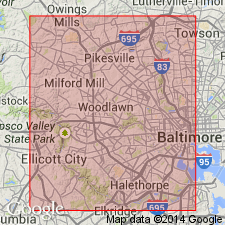
- Usage in publication:
-
- Baltimore gabbro (informal)
- Modifications:
-
- [Original reference]
- Dominant lithology:
-
- Gabbro
- AAPG geologic province:
-
- Piedmont-Blue Ridge province
Summary:
Baltimore gabbro (informal). Include: (1) fine-grained, purplish-black aggregate of hypersthene, diallage, and plagioclase, to which the name "hypersthene-gabbro" is applied; (2) a dark-green rock, composed of fibrous hornblende and plagioclase, which the writer has designated as "gabbro-diorite"; and (3) a group of rocks characterized principally by the large amount of olivine which they contain, and on this account to be referred to "the family of peridotites." Age is unknown; considered pre-Cambrian or Archean.
Occupy a roughly oval area of about 50 sq mi in and around the city of Baltimore, MD.
[Subsequent geologists . Not to be confused with formal Baltimore Gneiss of Williams and Darton (1892) in same area.]
Source: Publication; Changes in stratigraphic nomenclature, 1969 (USGS Bull. 1324-A, p. A127-A128).
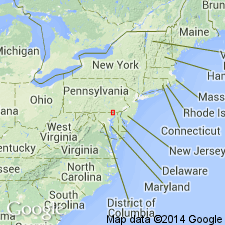
- Usage in publication:
-
- Baltimore gabbro
- Modifications:
-
- Overview
- AAPG geologic province:
-
- Piedmont-Blue Ridge province
Summary:
Baltimore gabbro is intrusive into Glenarm series. [This is only the second documented use of the name Baltimore gabbro in geologic publications. Workers in the area subsequent to Williams (1886) and previous to Cloos and Hershey (this reference) left the gabbros, serpentinites, and other mafic and ultramafic rocks near Baltimore unnamed in their reports according to Higgins (1977).]
Source: GNU records (USGS DDS-6; Reston GNULEX).

- Usage in publication:
-
- Baltimore gabbro
- Modifications:
-
- Overview
- AAPG geologic province:
-
- Piedmont-Blue Ridge province
Summary:
Pg. 33 (table 1), 217-236, pl. 1, 41. Baltimore gabbro. Occurs in peneplained area and occupies a structural basin in the Glenarm series and Baltimore gneiss. Age is post-Early Ordovician.
Source: US geologic names lexicon (USGS Bull. 1200, p. 207).
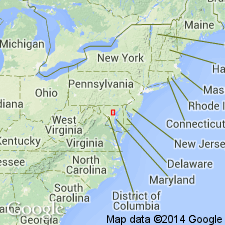
- Usage in publication:
-
- Baltimore gabbro complex
- Modifications:
-
- Revised
- AAPG geologic province:
-
- Piedmont-Blue Ridge province
Summary:
Pg. 979-1015. Referred to as Baltimore gabbro complex. Intrudes Wissahickon and Peters Creek and is cut by quartzose intrusives including Relay diorite, Port Deposit granodiorite gneiss, and Ellicott City granite. The Relay occurs persistently along southeast margin of gabbro. Age is Paleozoic.
Source: US geologic names lexicon (USGS Bull. 1200, p. 207); supplemental information from GNU records (USGS DDS-6; Reston GNULEX).
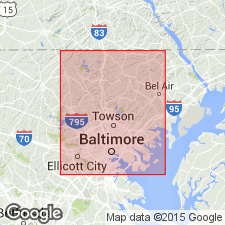
- Usage in publication:
-
- Baltimore Mafic Complex
- Modifications:
-
- Revised
- AAPG geologic province:
-
- Piedmont-Blue Ridge province
Summary:
The Baltimore Mafic Complex occurs in both the Laurel belt and the Bel Air belt in the Piedmont of MD. In the Laurel belt, the plutonic rocks of the Complex are here divided into two formal units: the Hollofield Layered Ultramafite (largely ultramafic rocks) and the Mount Washington Amphibolite (largely mafic rocks). In the Bel Air belt, rocks of the Baltimore Mafic Complex are here divided into the Raspeburg Amphibolite and the Bradshaw Layered Amphibolite. The Baltimore Mafic Complex stretches from Howard Co., MD, northeastward into PA. Contact with underlying Wissahickon Group interpreted as a fault; contact with overlying James Run Formation also a fault. Complex is thought to be a "partial ophiolite."
Source: GNU records (USGS DDS-6; Reston GNULEX).
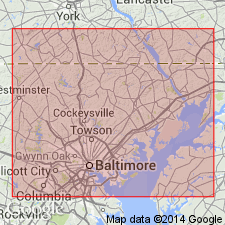
- Usage in publication:
-
- Baltimore Complex*
- Modifications:
-
- Revised
- Overview
- AAPG geologic province:
-
- Piedmont-Blue Ridge province
Summary:
The name of this complex of mafic and ultramafic rocks that extends from south of Baltimore to southeastern Pennsylvania is here changed to the Baltimore Complex. Name is retained because of long usage despite the fact that it is preempted by the nearby Precambrian gneiss formally known as Baltimore Gneiss. The Baltimore Complex is diverse in petrographic nature and in the arrangement of its rocks. Thickness is completely unknown. A general age of early Paleozoic is assigned.
Source: GNU records (USGS DDS-6; Reston GNULEX).
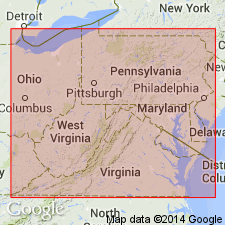
- Usage in publication:
-
- Baltimore Complex*
- Modifications:
-
- Areal extent
- AAPG geologic province:
-
- Piedmont-Blue Ridge province
Summary:
Baltimore Complex geographically extended into south-central Maryland and northern Virginia.
Source: GNU records (USGS DDS-6; Reston GNULEX).
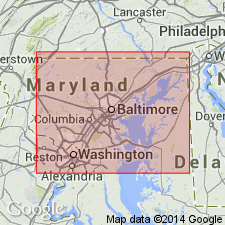
- Usage in publication:
-
- Baltimore Complex*
- Modifications:
-
- Areal extent
- AAPG geologic province:
-
- Piedmont-Blue Ridge province
Summary:
Baltimore Complex is geographically restricted from northern VA where it is replaced by newly named Piney Branch Complex. Usage of Baltimore Complex remains unchanged in northeastern MD and southeastern PA where it is correlated with Piney Branch.
Source: GNU records (USGS DDS-6; Reston GNULEX).
For more information, please contact Nancy Stamm, Geologic Names Committee Secretary.
Asterisk (*) indicates published by U.S. Geological Survey authors.
"No current usage" (†) implies that a name has been abandoned or has fallen into disuse. Former usage and, if known, replacement name given in parentheses ( ).
Slash (/) indicates name conflicts with nomenclatural guidelines (CSN, 1933; ACSN, 1961, 1970; NACSN, 1983, 2005, 2021). May be explained within brackets ([ ]).

